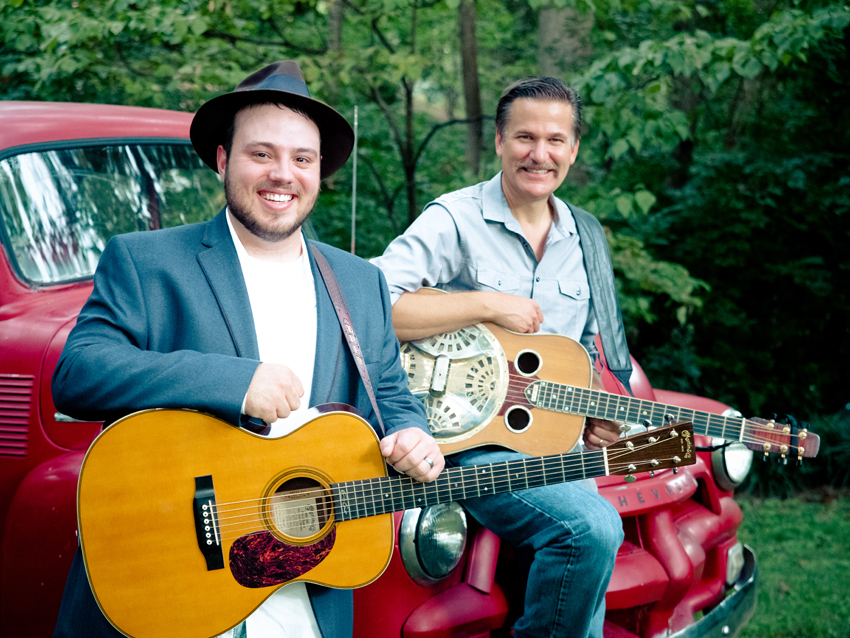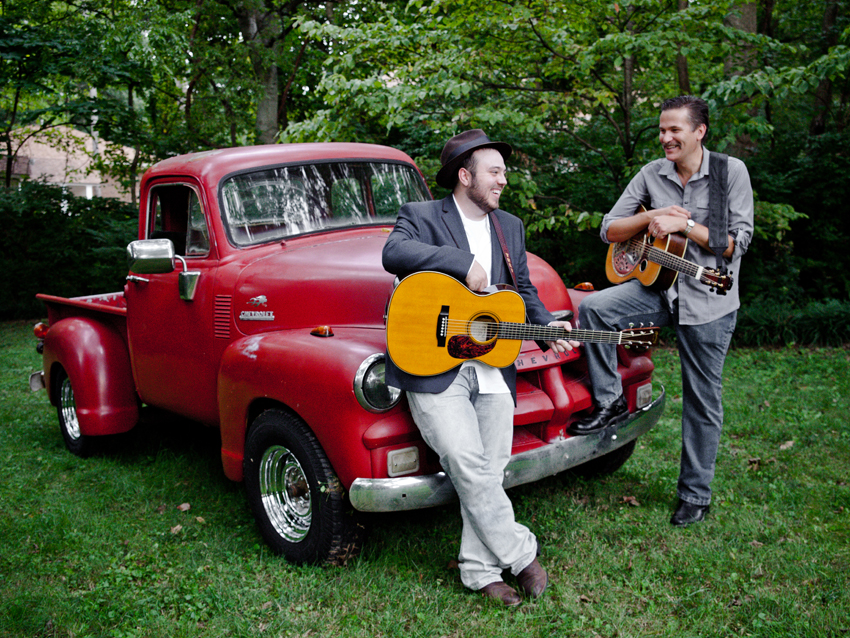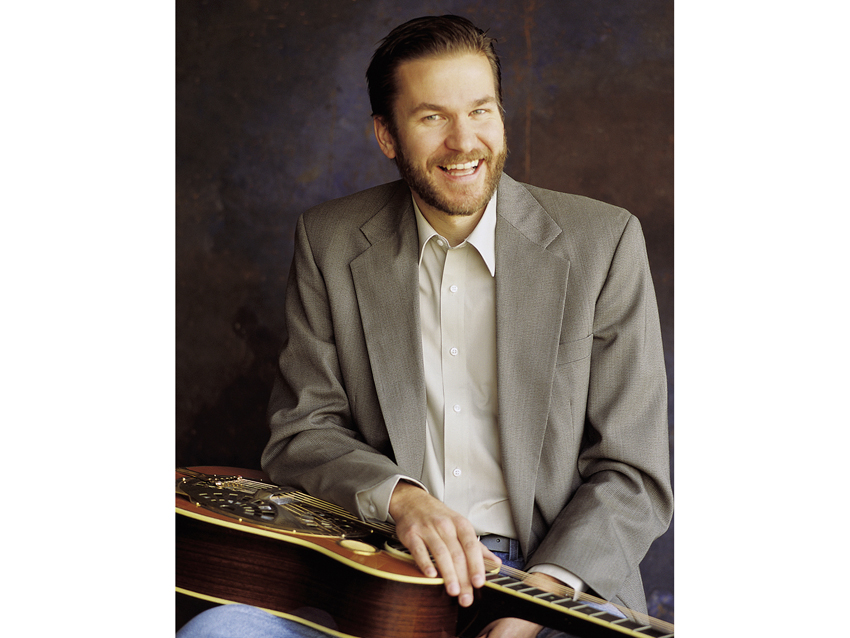Dobro master Rob Ickes talks Blue Highway, Three Bells and more
"The dobro is so bright... There's all this potential for metallic noise."

Dobro master Rob Ickes talks Blue Highway, Three Bells and more
Rob Ickes is northern Californian by birth, raising and demeanor. Even though he’s spent the last 22 years in Nashville, he still carries himself with a breezy zeal that’s very West Coast – and, as it happens, very in-demand musically. He’s one of the world’s most decorated resonator guitarists, named Dobro Player of the Year by the International Bluegrass Music Association a record 15 times to date.
The bluegrass band that Ickes co-founded two decades ago, and for which he handles some informal management duties, Blue Highway, is one of the strongest, most subtly sophisticated outfits in its genre. The quintet released a new album, The Game, early this year. Several months later, Ickes appeared alongside two other great dobro minds, Jerry Douglas and the late Mike Auldridge, on the singular instrumental album The Three Bells. And as 2014 draws to a close, Ickes is prepping a third project, this one a collaboration with Trey Hensley, a twenty-something picker-singer well on his way to mustering the sensitivity and down-home depth of Merle Haggard.
Ickes has backed the cream of the country and bluegrass crop in the studio, including Haggard, as well as Alan Jackson, Reba McEntire, Toby Keith, Dierks Bentley, Patty Loveless and Alison Krauss, and he started stretching out into jazzier, progressive first on solo albums, then with his trio Three Ring Circle. MusicRadar had to ask if it’s really as easy to stay lyrical, flexible and grounded in tradition while regularly detouring into flourishes of creativity as he makes it look.
These days, you have so many projects going at once. What mode are you in today?
“Trey [Hensley] mode. I’ve actually had a couple weekends off from Blue Highway. It’s nice to be home on the weekend. It’s kind of a rare thing. Everything’s kinda gearing up for getting this record out [with Hensley], so I’ve just kinda been working on that a lot.
“And I was just doing my Grammy ballot last night, and I forgot that The Three Bells was gonna be eligible this year. So it was kinda fun to vote for that.”
The Three Bells is an interesting project—three dobro players in a room and no other instrumentalists.
“Yeah, and that was something where Mike and I both thought that Jerry was crazy to do it that way.”
To suggest that you do this with no backing band, no rhythm section?
“Exactly. We thought that that was a little crazy. But then the first day we got together in the studio, it was amazing. Of course, Jerry’s an incredible technician, but he can also just play one note, the perfect note. With this record, it wasn’t a cutting contest, or a shoot-out, as Mike would call it. I mean, there’s some incredible playing on. But it wasn’t a contest – it was a conversation, a real musical conversation. And that was pretty apparent on the first song we cut.”

On guitarist Trey Hensley
Photo: Ickes (right) with guitarist Trey Hensley
It certainly doesn’t feel like you’re just trading solos. Some of the tracks spotlight one player or another, while the other two comp and play more rhythmic parts. You also play in different registers, so that you’re not all occupying the same tonal range all the time.
“Exactly. That’s what I noticed happened – everybody kind of found their spot, or spots. And they’d evolve. …I think the key is that these guys listened. That’s one thing I’ve always liked about the dobro, is that in the right hands, it’s such a great back-and-forth instrument, especially behind a great singer. There’s this conversation that can happen between a great singer and a dobro player. I learned from these guys. They’re the experts. I think there was a lot of that going on [during these sessions], where you’re listening to what the other person has to say, then saying something. You’re not just talking the whole time. I hope that came across. I think it did.”
You’re a virtuosic instrumentalist, but also a connoisseur of singers and songwriters. Trey Hensley, the young country singer, is a good example. He was pretty well beneath the radar when you encountered him, and you’ve since played a residency of sorts together in Nashville and produced an upcoming album on him. As a player, what did you hear him that excited you?
“I do this all the time, and I don’t hear stuff that I get excited about real often. And there was something in that vocal [he sang on Blue Highway’s song My Last Day In The Mine] that was super honest and pure. He’s so good on pitch and everything; that comes so easy to him that he can get into the storytelling, the soul of the lyric. I don’t even know if he knows he does it at this point, but he gives each lyric exactly what it needs.
“I called him at that point and said, ‘If there’s ever anything I can do to help ya, just let me know. I think you’re super talented.’ We talked about what he wanted to do. He wasn’t sure, bluegrass or country. I had a picking party here one night, and I had all these great players. It was probably about five or six people, some of the best players in town in our music. I just wanted to introduce people to Trey, and get him a gig, really.
“I’d never heard him play acoustic before. And I mean, he just wore it out. Everybody was really impressed. From there we started doing the Station Inn with [upright bassist] Mike Bub and [fiddler] Aubrey [Haynie] and some other guys. Basically, I just hear something super special in what he does, and I just want to shine a light on it if I can.”
You mentioned that he couldn’t decide between bluegrass and country. There are several Merle Haggard covers on this album, but the instrumentation’s primarily acoustic. How’d you arrive at that?
“I just try to do what fits. Trey has all these talents. I mean, he’s got this Stevie Ray Vaughan thing.”

Trey's diversity
And he covers Stevie Ray Vaughan on the album.
“Yes. He just eats it up on electric, and I thought, ‘That’s gonna be too far out for our audience,” [the audience] that we’re starting out with anyway. Because I’m well known in bluegrass. If we’d put that on there, it probably would have freaked out the audience. But I thought it would be great to do [Pride And Joy] on acoustic.
“He’s the kinda guy, we could’ve just done an electric album and featured his guitar playing, and that would’ve been amazing. But he also does all this bluegrass stuff. He knows all these fiddle tunes on acoustic, and he knows all the Tony Rice stuff, and all the Larry Sparks guitar stuff. I just captured what he does. So the songs we chose like I’d Rather Be Gone, that’s a Merle Haggard song, but to me, it’s always had a really killer kind of a bluegrass trio on the choruses.
“I guess I was also looking at this gig as a way for me to get more experience on lap steel. There’s a lot of dobro players or slide players that are gonna buy this album, so I wanted to feature that side of myself that I hadn’t really done that much. I played lap steel on some sessions and maybe one Blue Highway cut.”
It’s interesting to hear the way you think about incorporating rock and pop material. You’ve played on several albums in the Pickin’ On bluegrass covers series: Allman Brothers, Stevie Ray Vaughan, Santana and Eric Clapton editions, to name just a few. That dovetails with some of the material you’ve chosen for your solo albums. What’s the appeal of playing that stuff on dobro?
“I got into jazz really heavy when I was in college, and that opened my eyes to a lot of different stuff. I was totally into bluegrass up to that point. I didn’t want to listen to anything else. And then I heard Miles Davis and I was like, ‘Wow this is amazing.’ That got me into B.B. King, Larry Carlton and Robben Ford, a bunch of guitar players.
“The dobro is so obscure still. I don’t want to do a ton of it, but once in a while, it’s just fun to do something where people go, ‘Hey, I know that [song]—but it’s on a dobro.’ I think maybe it might draw people into it who didn’t have an appreciation for it before.”
You’ve said on other occasions that you don’t really consider yourself a jazz player, because you don’t have comprehensive knowledge of the jazz repertoire. But you’ve done a lot with jazz on your solo albums. On one, you covered Herbie Hancock, Earl Klugh and Miles Davis. That dobro-and-piano album you recorded with your kids’ elementary school music teacher was all jazz and classic pop. And jazz plays a big role in what you do with your trio Three Ring Circle. What’d it take for you to start wading in on those kinds of projects?
“It really comes from listening to Mike and Jerry. They were always such trailblazers with their solo albums. I love what I do with Blue Highway, but on my own stuff, I just feel like that’s part of the dobro player gig. Innovating is the tradition. Josh Graves was an outsider; there was no dobro in bluegrass before he was brave enough to accept the gig.
“Mike would do these amazing records, Eight String Swing, where he did all this swing stuff and Killing Me Softly and blues things. So it was very important to me when I got to the point where I could do my own records and have a career at this to make [my own solo albums] – I guess I was sort of making a statement that I think the dobro can do about anything.
“I did that one record called What It Is with saxophone and piano. I’m really proud of that record. I mean, I’ve gotten calls from Toots Thielemans and John Scofied saying that they really like this record. I feel like that was my hats-off to the music I’d loved, especially John Scofield. It’s kind of like my John Scofield dobro record.
“But I don’t think of myself as real adventurous. Jerry’s just a wild man. Some of that definitely rubbed off. It took a lot to be crazy enough to throw the dobro in with these great jazz guys. When I go far from home [musically] and do something like that, I just find that it’s all the same, you know? I got to spend a day with John Scofield a few years ago. It was so fun to play with him. I thought it’d be this weird, crazy thing, and it was like the easiest thing I’ve ever done. It’s just all about playing well and listening to the other guy.”

On Blue Highway
Three Ring Circle is your jazzy, jamgrass outfit with mandolin, dobro and upright bass. That’s as uncommon a configuration as three dobros. What does that outlet offer you?
“I feel like I learn so much from playing in that group. Because when you’re in a bluegrass band, there’s three or four instruments all in the same register. You’ve really gotta play hard to win some sonic space. In a smaller setting, a trio like that, I feel like I found parts of the instrument that I didn’t know existed.
“Those guys are amazing players too. [Fiddler/mandolinist] Andy [Leftwich] would bring these songs that he’d written, and I’d say, ‘There’s no way that I can play that on the dobro.’ Because, you know, you’re basically playing guitar with one finger on your left hand. And yet I liked what he was doing so much and it made sense to me, and I would find a way. It was difficult, but it wasn’t impossible. It pushed me in a really good way. [Bassist] Dave Pomeroy’s the same way. He just will get it done. He doesn’t care if it’s not been done before.”
The bluegrass band you’ve long been a part of, Blue Highway, doesn’t necessarily conform to what people think of as the standard bluegrass band. The group gets its identity as much from first-rate original songwriting as anything. What’s satisfying for you about that?
“There’s a lot of things that are really unique about Blue Highway, but the songwriting thing is so critical to me, and it’s what makes it continually fascinating, because they keep bringing these good songs. We have way more material than we need every time we go in the studio. It’s not like that for most bluegrass bands.
“[Singer/guitarist] Tim Stafford will write these songs, and a lot of them have really interesting chord progressions. Everybody in the band loves James Taylor and stuff that’s maybe more pop-oriented that you wouldn’t think a bluegrass band would listen to – but everybody in the band’s got really big ears. [Singer/multi-instrumentalist] Shawn [Lane] and [banjo player] Jason [Burleson] are great jazz players. Jason really knows a lot of Django Reinhardt stuff. And, of course, we’re all big Tony Rice fans, and Tony got way into that stuff.
“I don’t write much, but I can appreciate good lyrics. It gives me some good fodder to play off of as an instrumentalist. When I’m teaching, sometimes I’ll talk about backing up a singer, and I basically just say, ‘You’ve gotta listen to the lyrics and play what the song’s about.’ A lot of people have never thought about that before. I’ve always thought about it that way, as a listener even before I started playing: ‘Why did the guitar player play that behind the vocal right there?’ I guess that was always something I was hip to.”
You do compose instrumentals for the group. You contributed Funny Farm to The Game, and it sounds almost like a fiddle tune executed on dobro.
“I always liked fiddle. I mean, I was supposed to be a fiddle player. My grandpa played fiddle and gave me a fiddle when I was seven, and I never took it out of the box for some reason. [Fiddler] Stuart Duncan’s probably my favorite musician on the planet. There’ something about what he does that’s always struck me really hard and made a big impression on me. So I spend a lot of time listening to what fiddle players are doing and trying to find that for the dobro. So maybe that song is just a result of that interest.”
You were talking about teaching. You actually started a camp for dobro, what? Seven years ago?
“Yeah, about seven years ago. We’re coming up on the next one.”

The Sheerhorn
Things like music camps and apprenticing in bands play a big role in the bluegrass world for musicians coming up. What fruits have you seen your educational efforts bear so far?
“I’m very excited because there’s this kid who’s been coming. He’s been to all of ‘em probably. His name’s Gary Hultman. This year he started playing with the Boxcars, and they’re one of the best bands out there. He’s just a kid. He’s probably 19 or 20. And I’m so happy for him. I’m definitely gonna sing his praises in a few weeks when we have ResoSummit, because that’s why we’re doing this.
“I’ll be honest – most of our students aren’t that young, mostly middle-aged folks. But we love having kids and we do a scholarship every year where we bring a kid in and cover everything. It’s such a great instrument, and I would love it if it would someday reach the level of electric guitar. To me, it has that sound. When I got into electric guitar, you know, Larry Carlton and B.B. King, I learned a lot of those licks and they fit really well on the dobro. In my dreams, the dobro’s gonna eclipse the electric guitar in 2050, I think. [laughs]”
You have a reputation for largely sticking to your primary guitar, a Sheerhorn, rather than switching around. Why do you play what you play?
“I always tell people if I find a better guitar, I’ll start playing it. But I’ve just never found a guitar that I like any better than what Tim [Sheerhorn] does. I heard about his guitars when he first started building, back in ’90. Mike Auldridge told me about ‘em. I bought one a few months later.
“[Tim Sheerhorn] was the first guy to put really good, solid wood – maple that’s usually used for violins or mandolins. Before that, it was just plywood. So he did some design things that really brought out the low end of the guitar. He just sort of cleaned it up and souped it up.
"Then about the mid-‘90s, he built himself a guitar out of rosewood that I really liked, and he gave that one to me. I’ve played his rosewood model ever since. It’s warmer. The dobro is so bright. I mean, you have this metal bar on metal strings. There’s all this potential for metallic noise. And it seems like these rosewood guitars have more of a low end to them that appeals to me. I think you develop a relationship, or I do. Some guys switch instruments a lot. But I kinda get into this one thing and dig deeper into that thing.”